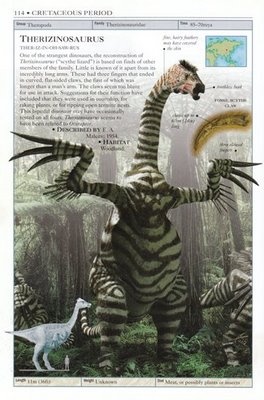
August 9, 2008
Since the 1990s, a large ‘reptilian’ creature has been sighted occasionally on Umbungi Island in West New Britain, Papua New Guinea. Umbungi Island is located on the south coast of West New Britain between Kandrian and Gasmata. The creature has also been sighted on Alage Island, about 1km to the south of Ambungi Island.
So begins Brian Irwin of “Creation on the Web” detailing his interviews of local residents of two islands on the south coast of West New Britain Province, Papua, New Guinea. Descriptions given by villagers seem to indicate to Irwin the presence of an alleged bipedal aquatic dinosaur that comes ashore to feed on vegetation. He says villagers picked out a dinosaur illustration from a book as most like what they saw.
Irwin observed that when shown the images in Hazel Richardson’s Dinosaurs And Prehistoric Life, one eyewitness identified a drawing of a Therizinosaurus as “closely matching the animal he observed, with the exception of one feature, i.e. the creature’s head.”

Specifically, Irwin writes of the cryptid’s appearance:
The creature was described as having a long tail and a long neck and was 10–15 metres in length, with an appearance like a ‘very large wallaby’ and having a head like a turtle’s head.
It walked slowly on two legs and had smooth, shiny brown skin. The top of the head was estimated to be as high as a house and the underbelly of the creature was as high as an adult.
You may read the entire passage on this here or here.
Irwin’s concluding remarks are heavily influenced by his Creationist point of view:
This is not the first time that dinosaur-like creatures have reportedly been sighted in Papua New Guinea—see e.g., A living dinosaur? If ever a ‘living dinosaur’ is found and confirmed to the satisfaction of the scientific fraternity, many people would be astonished, given the prevailing evolutionary view that dinosaurs died out 65 million years ago. Christians, however, should not be surprised, as the Bible teaches that God created the dinosaurs only around 6,000 years ago….So we needn’t be too taken aback if a theropod or sauropod dinosaur is ever confirmed to be living in the world today.Brian Irwin
Christians? Or just hardline Creationists?
A Papua New Guinea dinosaur population discussed does not mean that living theropods or sauropods have been found.
Dinosaurs have been reported from this corner of the world, rather infamously, before:
“During the 1930s, an explorer named Charles Miller brought out reports of a dinosaur from the Merauke subdistrict of Irian Jaya, Indonesia. It was said to be 30 to 40 feet long, yellowish brown, long-necked like a diplodocus dinosaur, and having a tail with a spike and a bony collar like a ceratopsian dinosaur. He saw it himself on his honeymoon, noting that it had a line of plates on its back, like a Stegosaurus. The animal was called a ‘Row’ because its hiss sounds like ‘roow.’ Miller also discovered a group of still unknown headhunting cannibals, the Kirrirri, who were using a ‘tusk’ (really the tail spike) from the Row. Miller in his 1939 book Cannibal Caravan, and his wife, Leona Miller’s 1941 book Cannibals and Orchids, stirred up considerable interest in searching for the Row. However, Bernard Heuvelmans and others felt this story was a hoax.” ~ The Field Guide to Lake Monsters, Sea Serpents, and Other Mystery Denizens of the Deep (NY: Tarcher/Penguin, 2003) pages 220-221.
Those looking more deeply than just the straight cryptozoological headlines being used (“Theropod and sauropod dinosaurs sighted…” and “Large Reptilian ‘Dinosaur-Like’ Creature Reported…”) with this case will naturally lead to criticism of Irwin’s investigations. Why? Because some Creationists seem, well, let me just say it, hell-bent on doing their cryptozoology with the whole idea that they have something to prove, namely, that evolution is wrong. This can get in the way of merely doing unbiased interviewing and analysis of the data.
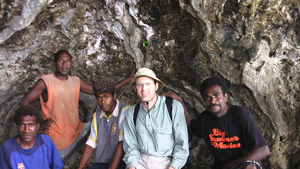
Brian Irwin with four locals from Umbungi Island. Creation Ministries International.
This approach routinely seems to revolve around dinosaurs still existing – in New Guinea (e.g. Irwin’s work) or in the Congo (e.g. Mokele-Mbembe, in general). Also, for some creationists, it seems to involve the fact that all native reports always sound similar to living dinosaurs. Their data regularly reinforces their theories, and gets translated immediately into their objective being reinforced ~ i.e. to prove that dinosaurs were only created 6,000 or so years ago.
This naturally causes a lot of conflict in some quarters, and makes the production of cartoons such as the following a severe and unfortunate by-product.
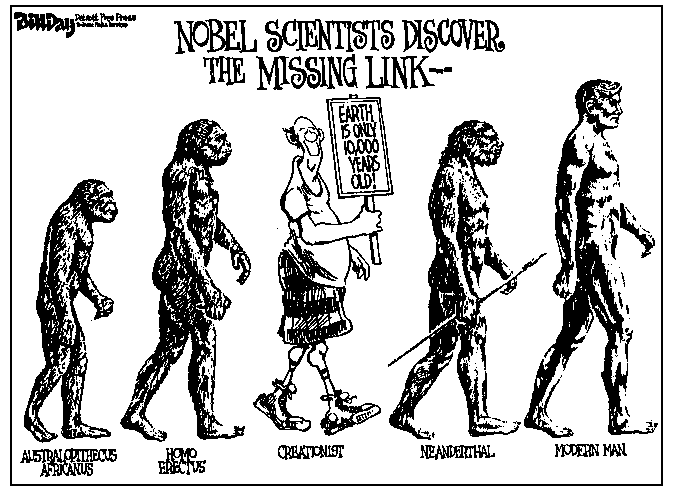
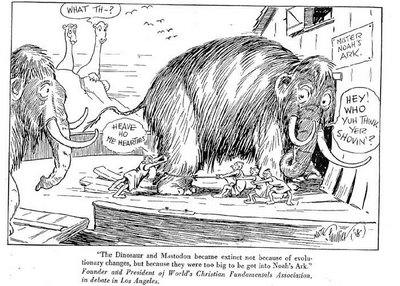
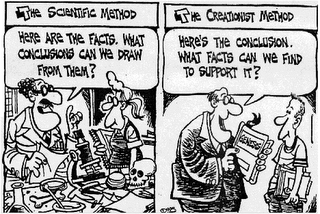
Frankly, the few creationist cryptozoologists I know do seem an intelligent lot, in which I can share mutual goals to find the reported cryptids without getting bogged down in any religious dogma or debates (most of the time).
For example, I respected Scott T. Norman keeping his religious thoughts in check when he was doing his cryptozoology, and he respected me not hitting him over the head with Science when he wanted to talk about his religious point of view.
I’m all for finding and verifying the dinos in the jungle, the swimming wallabies eating plants, or the aquatic rhinos in the rainforest before we get into saying they prove one thing or another in terms of the creation of life on Earth or the biodiversity of the planet!
Show me the animals!
BTW, New Guinea, which was until fairly recent geological times a part of mainland Australia, has at least five species of wallaby. Of these two drawings directly below, one is Native art of a wallaby from New Guinea, and the other is the earliest known European drawing of western Australian wallabies drawn from taxidermy mounts. They serve as good examples of what the human eye has seen in terms of these animals, which overall can be said to generally be similar to Irwin’s cryptids. As Heuvelmans wrote, most new animals go through a period of being made “fantastic” before discovery.

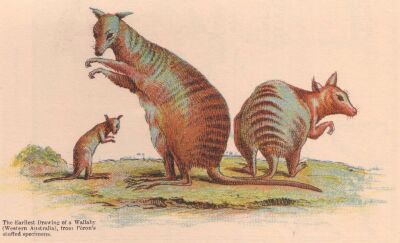
To round out this post, in terms of balance, here are also images of Therizinosaurus, including the first three being replicas that have been produced to represent the species.
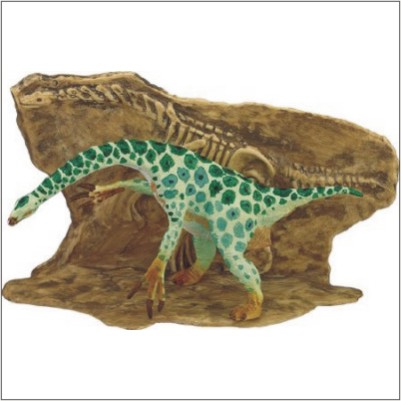
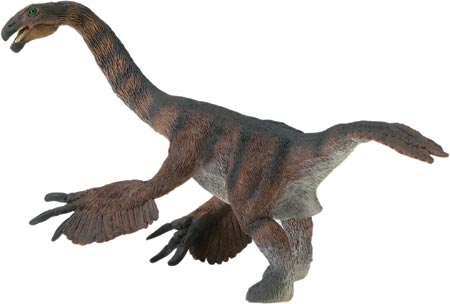
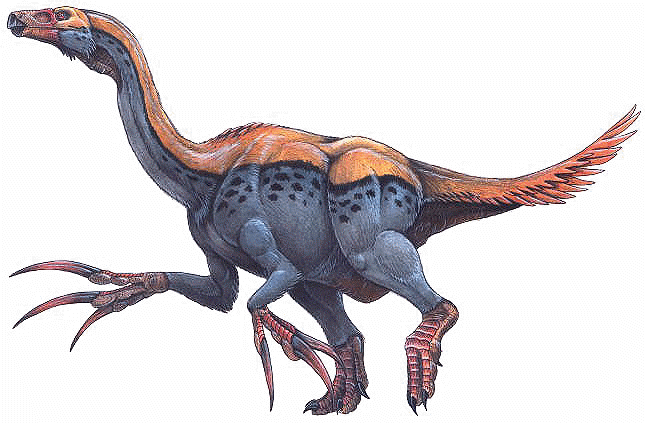
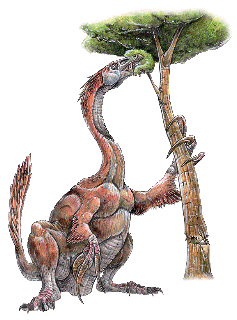
And finally, a rare image of a swimming wallaby leaping from the water:

About Loren Coleman
Loren Coleman is one of the world’s leading cryptozoologists, some say “the” leading living cryptozoologist. Certainly, he is acknowledged as the current living American researcher and writer who has most popularized cryptozoology in the late 20th and early 21st centuries.
Starting his fieldwork and investigations in 1960, after traveling and trekking extensively in pursuit of cryptozoological mysteries, Coleman began writing to share his experiences in 1969. An honorary member of Ivan T. Sanderson’s Society for the Investigation of the Unexplained in the 1970s, Coleman has been bestowed with similar honorary memberships of the North Idaho College Cryptozoology Club in 1983, and in subsequent years, that of the British Columbia Scientific Cryptozoology Club, CryptoSafari International, and other international organizations. He was also a Life Member and Benefactor of the International Society of Cryptozoology (now-defunct).
Loren Coleman’s daily blog, as a member of the Cryptomundo Team, served as an ongoing avenue of communication for the ever-growing body of cryptozoo news from 2005 through 2013. He returned as an infrequent contributor beginning Halloween week of 2015.
Coleman is the founder in 2003, and current director of the International Cryptozoology Museum in Portland, Maine.
Filed under Breaking News, Cryptomundo Exclusive, Cryptotourism, CryptoZoo News, Cryptozoologists, Cryptozoology, Expedition Reports, Extinct, Eyewitness Accounts, Living Dinosaurs, Mokele-Mbembe, Swamp Monsters